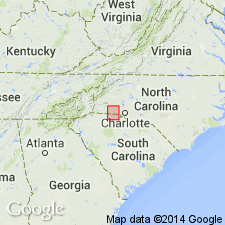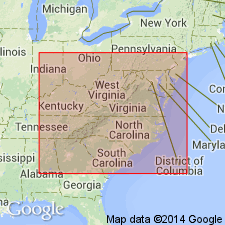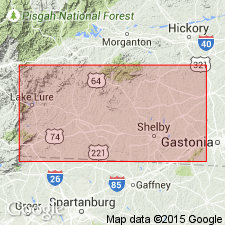
- Usage in publication:
-
- Bessemer granite*
- Modifications:
-
- Original reference
- Dominant lithology:
-
- Granite
- AAPG geologic province:
-
- Piedmont-Blue Ridge province
Summary:
Pg. 129. Bessemer granite. Medium- to fine-grained muscovite-biotite granite near quartz monzonite composition. Locally porphyritic. In all outcrops it has a strong schistose structure, and in many places it has been metamorphosed into white and gray quartz-sericite schist that bear no resemblance to the original granite. Only in certain favorable outcrops can the gradation from the schistose granite to sericite schist be seen. The porphyritic varieties have in some places been metamorphosed into quartz-augen sericite schist or "bird's-eye" schists. Age is pre-Cambrian.
[Named for fact that one of minor bodies of the granite underlies Bessemer City, Gaston Co., southern NC. Extends into northwestern SC.]
Source: US geologic names lexicon (USGS Bull. 896, p. 173-174).

- Usage in publication:
-
- Bessemer granite*
- Modifications:
-
- Incidental mention
- AAPG geologic province:
-
- Piedmont-Blue Ridge province
Summary:
Pg. 204. Bessemer granite. Mentioned in discussion of Shelby-Hickory district, North Carolina. [Age is Ordovician to Mississippian.]
Source: US geologic names lexicon (USGS Bull. 1200, p. 318).

- Usage in publication:
-
- Bessemer granite
- Modifications:
-
- Geochronologic dating
- AAPG geologic province:
-
- Piedmont-Blue Ridge province
Summary:
Pg. 116. Bessemer granite. Lead-alpha age 491 Ma.
[GNC remark (ca. 1960, US geologic names lexicon, USGS Bull. 1200, p. 318): The USGS currently designates the age of the Bessemer granite as Ordovician to Mississippian on the basis of a study now in progress. (See Overstreet and Bell, 1965.)]
Source: US geologic names lexicon (USGS Bull. 1200, p. 318).

- Usage in publication:
-
- Bessemer Granite*
- Modifications:
-
- Age modified
- AAPG geologic province:
-
- Piedmont-Blue Ridge province
Summary:
Pg. 45-47, 52, 89 (geol. time scale), 101, 109. Bessemer Granite. Age changed from Precambrian --to-- Ordovician to Mississippian. (Authors follow revised time scale of Holmes, 1959, Edinburgh Geol. Soc. Trans., v. 17, pt. 3, p. 183-216.)
Source: Publication; Changes in stratigraphic nomenclature, 1964 (USGS Bull. 1224-A, p. A16).

- Usage in publication:
-
- Bessemer†
- Modifications:
-
- Abandoned
- AAPG geologic province:
-
- Piedmont-Blue Ridge province
Summary:
Bessemer Granite abandoned and its metavolcanic and metasedimentary rocks are included in the Battleground Formation. Informal descriptive terms are recommended for the intrusive rocks which are not granites but metatonalites and metatrondhjemites.
Source: GNU records (USGS DDS-6; Reston GNULEX).
For more information, please contact Nancy Stamm, Geologic Names Committee Secretary.
Asterisk (*) indicates published by U.S. Geological Survey authors.
"No current usage" (†) implies that a name has been abandoned or has fallen into disuse. Former usage and, if known, replacement name given in parentheses ( ).
Slash (/) indicates name conflicts with nomenclatural guidelines (CSN, 1933; ACSN, 1961, 1970; NACSN, 1983, 2005, 2021). May be explained within brackets ([ ]).

